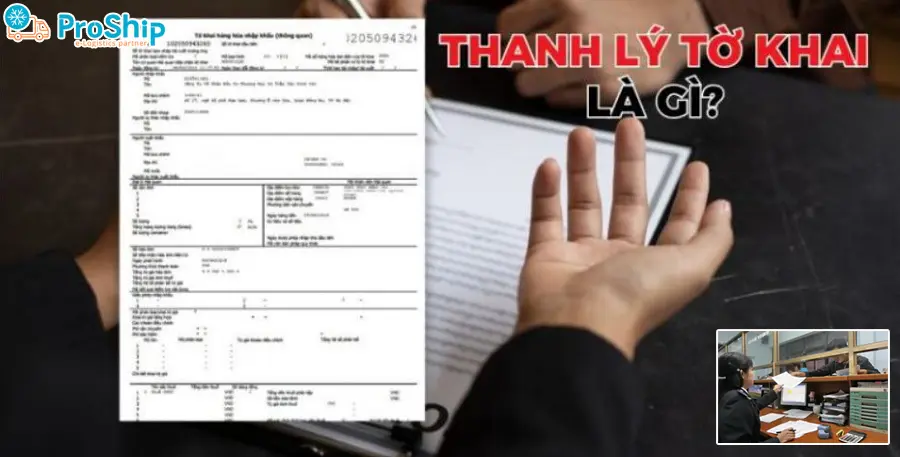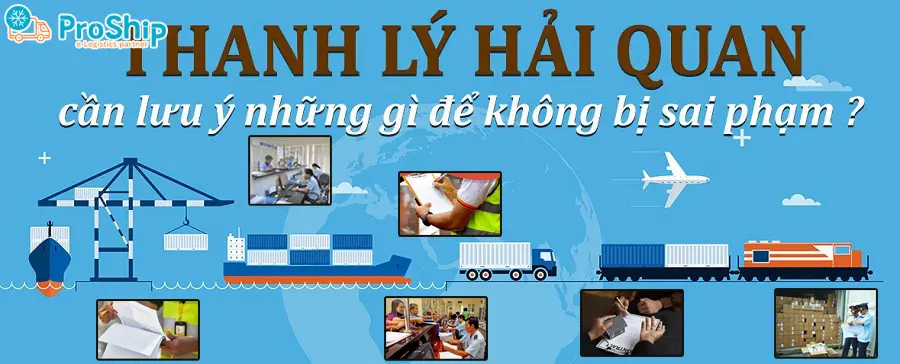Doanh nghiệp bạn không thể hoặc không muốn tiếp tục xuất khẩu hoặc nhập khẩu hàng hóa đã được KBHQ trong tờ khai hải quan nên cần thực hiện việc thanh lý tờ khai nhưng chưa hiểu rõ cần làm những gì? Các giao dịch xuất nhập khẩu hàng hóa của doanh nghiệp bạn không thành công hoặc không thực hiện được nên cần thanh lý tờ khai và thắc mắc việc làm này có ưu nhược điểm gì hay không? Tờ khai hải quan hàng XNK của bạn có sai sót nên cần thanh lý tờ khai để điều chỉnh và sửa đổi thông tin cho khớp nhưng chưa nắm quy trình từng bước tiến hành ra sao? Cần lưu ý những gì khi thanh lý hải quan?
Proship.vn chúng tôi sẽ giải đáp thanh lý hải quan là gì? Quy trình thực hiện thanh lý hải quan thế nào, có phức tạp không? Lý do cần phải thanh lý tờ khai hải quan là gì?,…Cùng với đó là một số lưu ý quan trọng cần biết trong quá trình tiến hành thanh lý hải quan mà các doanh nghiệp xuất nhập khẩu cần phải biết.
Thanh lý hải quan là gì? Tại sao cần thanh lý?
Bạn thắc mắc thanh lý hải quan là gì và tại sao cần phải thanh lý hải quan. Cùng Proship đi tìm câu trả lời sau đây:
Thanh lý tờ khai hải quan là gì?
Thanh lý hải quan là gì? Thanh lý hải quan là quá trình kiểm tra, xác nhận và chấp thuận thông tin trong tờ khai hải quan hàng hóa.
Trong quá trình này, tờ khai hải quan sẽ được xem xét kỹ lưỡng để đảm bảo tuân thủ quy định hải quan và các quy tắc liên quan. Điều này đòi hỏi thông tin đầy đủ và chuẩn xác về mô tả hàng hoá, giá trị, nguồn gốc, xuất xứ, mã hình học và các yêu cầu khác.

Lý do cần phải thanh lý hải quan
Doanh nghiệp cần phải thanh lý hải quan vì:
- Tuân thủ pháp luật:
Việc thực hiện thanh lý tờ khai đúng quy trình là biện pháp chắc chắn để doanh nghiệp tuân thủ quy định và tránh các vấn đề pháp lý tiềm ẩn.
- Đảm bảo thuế quan và thuế XNK:
Xác định và tính toán chính xác thuế quan và xuất nhập khẩu để tránh bị xử phạt hành chính cũng như các hậu quả pháp lý khác.
- Kiểm soát an ninh:
Thanh lý tờ khai hải quan giúp kiểm soát chặt chẽ hàng hóa, ngăn chặn vận chuyển hàng cấm, hàng giả mạo.
- Quản lý tài chính:
Quá trình thanh lý tờ khai hải quan giúp tối ưu hóa chi phí liên quan đến hải quan và quản lý tài chính hiệu quả.
- Thông quan và vận chuyển hiệu quả:
Thanh lý hải quan giúp giảm sự cố, trì hoãn và lỗi trong vận chuyển hàng hóa.
Ưu nhược điểm của thanh lý hải quan là gì?
Việc thanh lý tờ khai hải quan có ưu, nhược điểm sau:
Ưu điểm của thanh lý hải quan
Thanh lý hải quan có các ưu điểm:
- Giảm thiểu rủi ro và tranh chấp:
Khi thực hiện thanh lý tờ khai hải quan một cách kỹ càng và chính xác, doanh nghiệp có thể giảm thiểu các rủi ro liên quan đến việc chậm trễ thông quan, bị tạm giữ hàng hóa hoặc xảy ra tranh chấp hải quan.
- Tiết kiệm, tối ưu chi phí:
Tuân thủ quy định về thuế quan và thuế xuất nhập khẩu giúp doanh nghiệp tránh sai sót và mất tiền. Việc này giúp tối ưu hóa tài chính và giảm rủi ro tài chính không mong muốn.
- Tối ưu hóa quy trình thông quan:
Khi các thông tin và tài liệu được cung cấp đầy đủ và hợp lệ, doanh nghiệp có thể tránh bị yêu cầu bổ sung thông tin hoặc kiểm tra hàng hóa. Điều này giúp tăng tốc độ thông quan hàng hóa và giảm thiểu thời gian, chi phí liên quan.

Nhược điểm của thanh lý hải quan
Bên cạnh ưu điểm, thanh lý hải quan còn nhược điểm:
- Chi phí phát sinh:
Doanh nghiệp có thể phải chịu thêm các chi phí liên quan đến việc kiểm tra, lưu kho và nộp thuế trong quá trình thanh lý hải quan.
- Phức tạp và tốn thời gian:
Quy trình thanh lý hải quan đòi hỏi sự chuẩn xác và tuân thủ nghiêm ngặt quy định pháp luật, có thể làm mất nhiều thời gian và công sức của doanh nghiệp.
Những lưu ý khi thanh lý tờ khai hải quan
Những lưu ý khi thanh lý hải quan là gì? Đó chính là:
Tài liệu và thông tin chính xác
Đảm bảo tài liệu và thông tin liên quan đến hàng hóa và tờ khai là chuẩn xác và đầy đủ. Thông tin sai sót hoặc thiếu sót có thể gây phạm lỗi pháp lý và cản trở quá trình thanh lý.
Đối tác liên quan
Trong quá trình thanh lý, có thể liên quan đến các đối tác như Công ty vận chuyển, Chuyên gia hải quan, Ngân hàng và các bên liên quan. Đảm bảo sự liên kết và hợp tác tốt với các đối tác này để quá trình thanh lý diễn ra thuận lợi.
Tuân thủ quy trình hải quan
Phải tuân thủ quy trình và quy định của cơ quan hải quan liên quan khi thực hiện thanh lý tờ khai. Bao gồm việc sử dụng biểu mẫu chính xác, nộp đúng thời hạn, và tuân thủ quy định về thanh toán thuế và phí hải quan.
Phí và thuế hải quan
Trong quá trình thanh lý, có thể phát sinh các khoản phí và thuế hải quan. Đảm bảo tính toàn vẹn tài chính và chuẩn bị nguồn lực phù hợp để đảm bảo thanh toán các khoản phí và thuế này đúng hạn.
Thủ tục và thời gian xử lý
Quá trình này có thể yêu cầu tuân thủ các thủ tục và quy trình phức tạp, đồng thời cũng mất thời gian để xử lý. Để tránh trễ hạn và rủi ro, cần đảm bảo quá trình thanh lý bắt đầu đúng thời điểm và được tiến hành nhanh, kỷ luật.
Quy định thực hiện thanh lý hải quan thế nào?
Quy định thanh lý tờ khai hải quan điện tử gồm các bước:
Bước 1: Đăng ký và cung cấp thông tin doanh nghiệp
Đăng ký tài khoản trên hệ thống hải quan điện tử hoặc sử dụng Dịch vụ thanh lý tờ khai hải quan của các đơn vị cung cấp giải pháp thanh lý hải quan. Sau đó điền thông tin doanh nghiệp và hàng hóa cùng các tài liệu liên quan khác.
Bước 2: Xác nhận và kiểm tra tính hợp lệ
Bước này được thực hiện bởi hệ thống hải quan điện tử. Hệ thống sẽ tiến hành kiểm tra độ chính xác, hợp lệ của thông tin và các quy định pháp luật liên quan.
Bước 3: Thực hiện thanh lý tờ khai hải quan
Sau khi xác nhận thông tin và đảm bảo tính hợp lệ sẽ tiến hành thanh lý tờ khai hải quan. Trong quá trình này, bạn sẽ hoàn thành biểu mẫu, cung cấp thông tin chi tiết về hàng hóa và tuân thủ các yêu cầu liên quan đến quá trình thanh lý.

Bước 4: Hệ thống xử lý và xác nhận thanh lý
Khi tờ khai hải quan được gửi đi, hệ thống sẽ xử lý và xác nhận thanh lý. Quy trình gồm kiểm tra lại thông tin và xác định các khoản thuế và phí liên quan.
Bước 5: Lưu trữ và tạo báo cáo
Cuối cùng, thông tin thanh lý hải quan sẽ được lưu trữ trong hệ thống điện tử. Bạn có thể tự do truy cập và tìm kiếm mọi lúc.
Thanh lý hải quan là gì, quy trình thanh lý được thực hiện ra sao, tại sao phải thanh lý tờ khai hải quan, thanh lý hải quan có ưu nhược điểm gì, cần lưu ý gì khi thanh lý hải quan,…đã được Proship Logistics giải đáp ở trên. Quý doanh nghiệp, chủ hàng có nhu cầu sử dụng Dịch vụ thanh lý hải quan, liên hệ ngay 0909 344 247 để được tư vấn và báo giá trực tiếp.

